|
|
|
Fresh from the Field is a weekly album showcasing transformative impacts made by grantees funded by the National Institute of Food and Agriculture.
May 4, 2017
|
|
|
This
week, National Small Business Week, we acknowledge the accomplishments of the
USDA’s Small Business Innovation
Research (SBIR) program. The
SBIR program at USDA is administered exclusively by the National Institute of
Food and Agriculture (NIFA). SBIR program awards are based on the scientific
and technical merit of investigator initiated ideas. The SBIR Program does not
make loans and does not award grants for the purpose of helping a business get established.The competitive grant program is offered to qualified small
businesses to support high quality research related to important scientific problems
and opportunities in agriculture that could lead to significant public
benefits. The program supports technological innovations in the private sector
and strengthens the role of federal research and development in support of
small businesses. The SBIR program also fosters and encourages participation by
women-owned and socially or economically disadvantaged small businesses.
Success Stories
 Ames, Iowa small business
battles major epidemic
In
2014, the porcine epidemic diarrhea (PED) virus was responsible for the death
of eight million piglets in the United States. Developing a vaccine took
months—sometimes years—making it hard to rescue the declining swine community. Harrisvaccines,
in Ames, Iowa, used its patented SirraVaxSM technology to analyze PED gene
sequences to commercialize a vaccine in just four months. Harrisvaccines
became the first company in the country to gain conditional licensure from
USDA. The vaccine, called iPED, is administered to sows right before they give
birth to a litter, protecting the piglets.
To
produce their customized vaccines, Harrisvaccines collects saliva,
blood, or tissue samples from infected animals and sends them to state or
private diagnostic labs to extract gene sequences. The gene-sequencing codes
provide the blueprint for the specific pathogen strain on each farm. The
sequences are added to an information library to rapidly develop herd-specific
vaccines.
NIFA supported this research through funding from USDA’s Small
Business Innovation Research Program.
Read more on the Harrisvaccines breakthrough.
|
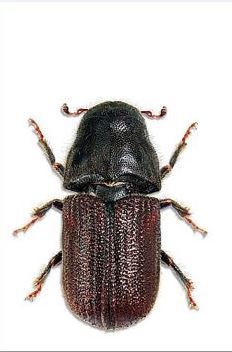 SPLAT goes the beetle
All 19 Western states and parts of Canada are dealing with mountain pine
beetle (MPB) attacks, and this ongoing, area-wide infestation has devastated 27
million acres of forests. This caused ecosystem disruption, water
contamination, rising carbon levels, and thousands of miles of power line
damage due to falling trees.
With USDA SBIR funding, ISCA Technologies introduced a
highly effective pest control product that targets mountain pine beetles. The
repellent uses one of the beetle’s own pheromones, called verbenone, a chemical
which tells beetles to find another host tree.
The repellent, called SPLAT Verb (Specialized Pheromone and Lure
Application Technology), is a non-toxic alternative to pesticides.
Learn more about SPLAT Verb.
|
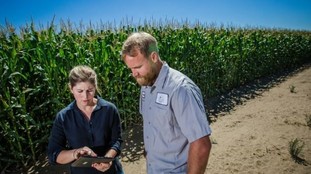 Water saving
measures for California
California
is the nation’s top agricultural producer, responsible for two-thirds of the
country’s fruits and nuts and more than one third of its vegetables. The
state’s ag-focused economy means farmers have historically been power players
in politics, especially in discussions about apportioning water.
Farms
and ranches in the Golden State constitute a $54 billion annual industry. In
2015, during a record-setting drought, California Governor Jerry Brown
instructed cities and towns to reduce water use by 25 percent, the first
cutback in state history.
George McFadden, a field agronomist for Ceres
Imaging, headquartered in Oakland, California, uses aerial imagery to help
farmers optimize water and fertilizer application. Funding for this research
was supported through USDA’s SBIR program.
When it launched in 2014, Ceres focused
on lucrative nut crops in the Central Valley, but soon expanded to other crops
in California, the Midwest, and even Australia.
To assess
fields, Ceres hires pilots who fly their aircraft low over the ground.
The company attaches special cameras that focus on particular wavelengths to
gauge water stress, chlorophyll content, and biomass—all indicators of health
in a crop. Within 24 to 48 hours, growers can view imagery on phones or
tablets, which McFadden says are popular with growers in the field.
Ceres offers a unique, proprietary product to
measure chlorophyll content and its guidance for growers is also unique.
Ceres has teamed up with the University of California Cooperative
Extension to conduct several studies, including a trial for the Almond
Board of California that measured the response of nuts to different rates of
watering.
Read more about Ceres Imaging.
|
News Coverage
 May the forest be
with you
Whole
Trees, LLC, of Madison,
Wisconsin, uses trees as turn-key structural systems in commercial and
residential building construction. The Whole Trees team, in partnership with
the U.S. Forest Service’s Forest Products Laboratory, has developed a process
that allows them to cost-effectively grade, engineer, and manufacture the small
trees removed from routine forest thinning. This small-diameter, round timber
is used in patented trusses, beams, and joists in building construction. The
process turns forest waste into a sustainable and high-value building material.
The
company, a four-time SBIR grantee, has increased its local revenue from
$150,000 to $4 million and doubled its staff. Construction projects that use
Whole Trees products receive triple the amount of Leadership in Energy and
Environmental Design credits for green structural material.
Read
more on Forbes coverage of Whole Trees.
|
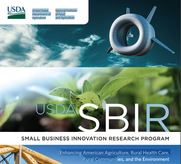 2016 SBIR brochure
The Small
Business Innovation Research Program is helping thousands of rural businesses
expand on new ideas to benefit their own operations and the country.
Since 1983, the SBIR program
has awarded more than 2,000 research and development grants to American-owned,
independently operated, for-profit businesses with 500 employees or fewer.
Read about USDA’s Small
Business Innovation Research program and other SBIR success stories in this NIFA brochure.
|
Video
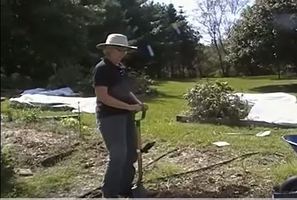 One size fits all is a myth
Green Heron Tools in New Tripoli, Pennsylvania is a company that empowers women by
creating agricultural and gardening tools that are designed to work with
women’s bodies. NIFA has supported the efforts of Green Heron Tools with three
Small Business Innovation Research (SBIR) grants totaling more than $572,000.
In Green Heron’s first SBIR grant, the company set design
parameters for tools and equipment designed for women, created prototypes of
three hand tools, including the “hergonomic” HERShovel, and established design concepts for a rototiller for use by women. Hergonomic is Green Heron’s
trademarked term, meaning ergonomic for women.
“One-size-fits-all" is and always has been a myth,” said
Liz Brensinger, Green Heron Tools co-founder. “It’s convenient for
manufacturers and a disservice for consumers. One of the most basic principles
of ergonomics is that tools should fit, yet that principle has been ignored.”
Watch the video Green
Heron video.
|
Tweet of the Week
#NIFAIMPACTS
|
|
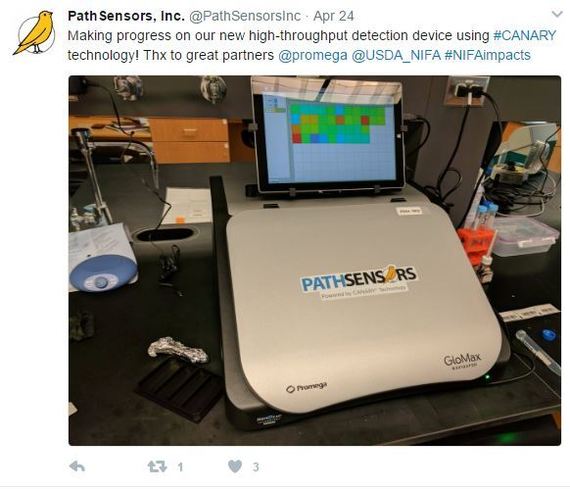 
For more NIFA Impacts, visit nifa.usda.gov/impacts or the Land-Grant University Impacts website. Send us your NIFA-funded impacts at impactstories@nifa.usda.gov or share them on Twitter @USDA_NIFA, #NIFAimpacts.
NIFA invests in and advances agricultural research, education, and extension and promotes transformative discoveries that solve societal challenges.
Fresh from the Field is a weekly compendium of news and information that may be of interest to land-grant and non-land-grant universities, NIFA stakeholders, and other subscribers.
Editor: Falita Liles; Co Editor: Carlos Harris
|
|
|
|